Key takeaways on financial reporting software
- To cut down on time spent manually entering and checking numbers, financial reporting software automates tasks like data collection and report generation.
- The best financial reporting tools let you create reports and finance dashboards that match your business needs and seamlessly integrate with software you already use, such as spreadsheets or ERP systems.
- Finance teams can use financial reporting software to quickly understand their financial situation and react to changes.
Top financial reporting software: Quick review
Enterprise financial reporting software:
- Cube: Enables finance teams to manage reporting, planning, and forecasting directly within Excel and Google Sheets. Offers AI-powered analysis, smart variance detection, and integrations with ERPs, CRMs, and HRIS systems.
- Oracle NetSuite: Offers financial management and reporting features for global businesses.
- Sage Intacct: Provides flexible reporting tools, dimensional tagging for deeper insights, and automation for consolidations and audit prep
- Insight Software: Focuses on real-time reporting with Excel-based interfaces and integration across major ERPs.
- Workday Adaptive Planning: Combines planning, modeling, and reporting in one cloud-native platform.
- Board: Combines business intelligence and financial planning tools into a unified platform.
- Planful: Helps large teams streamline reporting and forecasting with automated consolidations, role-based access, and audit capabilities.
- Multiview ERP: Centralizes financial operations and improves audit readiness.
- SAP S/4HANA Finance: Offers advanced analytics, predictive forecasting, and global compliance support.
- Workiva: Centralizes ESG, audit, and financial reporting.
- Jedox: Gives FP&A teams AI-powered forecasting, multidimensional analysis, and Excel-like modeling.
- Microsoft Dynamics 365 Finance: Offers live data insights, workflow automation, and native integrations with Excel and Power BI.
Small business financial reporting software:
- Sage 50 Cloud: Support basic financial reporting, budgeting, and tax prep for small businesses.
- Datarails: Enhances FP&A in Excel with financial automation and centralized data management.
- Jirav: Offers pre-built dashboards, forecasting tools, and Excel-like functionality for fast-growing startups.
- Xero: Delivers user-friendly reports and real-time financial dashboards.
- Synoptix: Provides direct database connections for faster reporting.
- Vena Solutions: Helps small teams automate reports, monitor KPIs, and collaborate on forecasts.
- Intuit QuickBooks: Offers built-in financial reports, real-time dashboards, and integration with payroll and tax tools.
- FreshBooks: Offers simple profit-and-loss reporting, invoicing, and expense tracking in an intuitive interface.
- Zoho Books: Covers invoicing, reporting, and compliance in a streamlined platform.
- Wave: Offers basic financial reporting, invoicing, and expense tracking.
Why is financial reporting essential to a successful business?
CFOs rely on strong financial reporting to provide key stakeholders with important insights. Typically, businesses generate three main accounting financial statements as part of their reporting process: income statements, balance sheets, and cash flow statements. This data drives informed decision-making and, ultimately, business growth. Effective financial reporting also promotes real-time, productive discussions within the organization. For example, a CFO can quickly perform ad hoc reporting to assess the potential impact of reallocating funds, ensuring swift and informed decision-making.
What is financial reporting software?
Financial reporting software speeds up the financial reporting process with automation and analysis. It helps finance teams with these basic accounting tasks:
Types of financial reporting software
It’s important to note that different types of finance software will have different capabilities.
Today, we'll discuss financial reporting software. However, during your search, you may also encounter:
Benefits of using financial reporting software
Using financial reporting software offers numerous advantages that can transform the efficiency and accuracy of your financial operations. Here are some key benefits:
Trend identification
Financial reporting software helps businesses identify trends by analyzing historical data and comparing it with current performance.
By tracking patterns over time, companies can gain valuable insights into their financial health and market dynamics. This capability enables businesses to anticipate market shifts, recognize growth opportunities, and adjust strategies proactively.
For example, a retail company might use trend analysis to identify seasonal buying habits, allowing them to optimize inventory and marketing efforts accordingly.
Real-time insights
Financial reporting tools provide real-time access to financial data, empowering stakeholders to make informed decisions swiftly. This immediacy is crucial for maintaining agility in a competitive market.
With real-time insights, companies can respond promptly to emerging opportunities or challenges.
For instance, a sudden drop in sales can be quickly identified and addressed with targeted promotional campaigns or adjustments in pricing strategies. The ability to act on up-to-date information helps businesses stay ahead of the competition and capitalize on market trends.
Time and labor cost savings
Automating financial reporting processes significantly reduces the time and labor required for manual data entry and report generation. This automation frees up valuable resources, allowing your finance team to focus on more strategic activities such as financial planning, analysis, and decision support.
For example, instead of spending hours compiling monthly financial statements, the finance team can devote their efforts to identifying cost-saving opportunities or exploring new revenue streams. This increased efficiency leads to cost savings and improved overall productivity.
Accurate data and consequently informed business decisions
Automation in financial reporting minimizes human error, ensuring the data used for decision-making is accurate and reliable.
Accurate data is the foundation of effective business strategies. When financial information is precise, business leaders can confidently make informed decisions that drive growth and profitability.
For instance, accurate cash flow projections can help a company manage liquidity effectively, avoiding potential cash shortages and optimizing investment opportunities.
Better collaboration and cohesion across teams
Financial reporting software often includes features for sharing and collaboration, making it easier for teams across the organization to work together and stay aligned.
Collaborative tools allow finance, operations, marketing, and other departments to access and analyze the same financial data, fostering a unified approach to achieving business goals.
For example, a collaborative budgeting process ensures that all departments are working towards the same financial objectives, reducing the risk of misalignment and enhancing overall organizational cohesion.
Smaller chance of human error
By automating data collection and reporting, financial reporting tools significantly reduce the risk of human error.
Manual data entry is prone to mistakes, which can lead to inaccurate financial statements and misguided business decisions. Automation ensures that data is collected consistently and accurately, providing a reliable foundation for financial analysis.
For instance, automated reconciliation processes can detect and correct discrepancies in financial records, ensuring that reports are precise and trustworthy. This reduction in errors enhances the credibility of financial information and supports better decision-making.
Critical features of financial reporting software
Here's what the best financial reporting software solutions offer:
Automation workflows
Financial reporting software automates many routine tasks, such as pulling updated data from your source systems, streamlining the reporting process, and reducing the workload on your finance team.
By automating these workflows, businesses ensure that financial data is consistently updated and accurately reflected in reports without manual intervention.
For example, the software can automatically retrieve transaction data from accounting systems, update financial statements, and generate monthly performance reports. This not only saves time but also reduces the risk of errors associated with manual data entry.
Additionally, automated workflows can trigger alerts for anomalies or discrepancies, ensuring that potential issues are identified and addressed promptly. Overall, automated financial reporting workflows enhance efficiency, accuracy, and timeliness in financial reporting, allowing finance teams to focus on more strategic tasks.
Custom financial report creation
Financial reporting software allows for the creation of custom financial reports tailored to an organization's specific needs.
Standard reports like balance sheets, income statements, profit and loss statements, and cash flow statements are essential for regulatory compliance, tax purposes, and performance assessment.
However, businesses often require more detailed or specific insights to inform strategic decisions. Custom financial report creation enables organizations to generate reports that reflect their unique financial circumstances and operational priorities.
For instance, a company might need a detailed expense analysis report to identify cost-saving opportunities or a custom revenue report that breaks down sales by product line and geographic region.
By providing the flexibility to design and generate bespoke reports, financial reporting software helps businesses gain deeper insights into their financial health, supporting data-driven decision-making and strategic planning.
Flexible dashboards
Flexible dashboards allow users to customize their view of financial data, displaying key metrics and reports in an intuitive, easily accessible format. Some features of a flexible dashboard include:
- Customizable layouts
- Real-time data updates
- Interactive visualizations
- Data integration
- User-friendly interface
- Advanced filtering and segmentation
- Collaboration tools
- Alerts and notifications
Easy drill-downs
These tools offer the ability to drill down into financial data, a vital feature of financial reporting software because it enhances the depth, accuracy, and usability of financial data analysis. Here's why this feature is critical:
- Granular data access: Move from high-level summaries to detailed transactions to identify root causes and understand factors driving financial performance.
- Scenario analysis: Explore how different factors affect financial outcomes, aiding strategic planning and risk management.
- Quick insights: Quickly access needed data within the same platform, eliminating the need to sift through spreadsheets or request additional reports.
Data validation and error-checking
Financial reporting software includes data validation and error-checking features to ensure the integrity and reliability of financial data. Here's what these essential features provide:
- Elimination of errors: Automated mechanisms identify and correct errors, ensuring accurate, discrepancy-free reports.
- Consistency: Enforces consistency in data entry and processing, reducing the risk of conflicting or duplicated information.
- Regulatory compliance: Ensures financial reports meet regulatory standards like GAAP or IFRS.
- Audit trails: Creates detailed audit trails for documenting changes and corrections, aiding in audits and maintaining compliance.
- Risk reduction: Minimizes errors to reduce the risk of poor decision-making, enhancing strategic planning and risk management.
Source system integrations
The best financial reporting software integrates with your ERP, HRIS, and other source systems that house critical information about your finances, payroll, and compliance. This integration ensures a seamless flow of data and reduces the need for manual data entry.
Here’s why these integrations are crucial for realistic financial reporting:
- ERP (Enterprise Resource Planning): Integrates financial data with business processes for a comprehensive operational view. (e.g., Oracle NetSuite, SAP S/4HANA)
- CRM (Customer Relationship Management): Links sales and customer data with financial metrics for revenue and profitability insights. (e.g., Salesforce, HubSpot)
- HRIS (Human Resource Information System): Connects payroll and employee data to manage labor costs and analyze HR decisions' financial impact. (e.g., Workday, ADP)
- BI (Business Intelligence) tools: Combines data from various sources for advanced analytics and visualizations. (e.g., Tableau, Power BI)
- Accounting software: Ensures accurate data entry and streamlines financial close processes. (e.g., QuickBooks, FreshBooks)
- Invoicing and payment systems: Tracks receivables and payables for improved cash flow management. (e.g., Stripe, PayPal)
- Tax management software: Automates tax calculations and compliance reporting. (e.g., Avalara, TurboTax)
- Budgeting and financial planning tools: Supports scenario analysis and long-term financial planning. (e.g., Cube, Anaplan, Planful)
- Financial consolidation software: Merges data from multiple entities for a unified financial view. (e.g., Cube, BlackLine, OneStream)
Advanced security
Financial reporting software must be secure, preferably SOC 2 Type 2 compliant, to protect your business's financial information. Advanced security features protect sensitive financial data from unauthorized access and breaches.
Critical security features to look for include:
- Full encryption: Ensures data encryption both at rest and in transit.
- Authorization and user management: Customizes controls to provide the right access to the right users.
- Multi-factor authentication (MFA): Adds an extra layer of security with text or app-based authentication.
- Single sign-on (SSO): Simplifies access through multiple apps using SSO.
- Role-based access and permissions: Limits access to sensitive data and provides dimension-based security by department, entity, or territory.
Best financial reporting software for larger businesses
Larger businesses have more complex reporting needs like consolidating data across entities or complying with strict audit requirements. Let’s look at the best financial reporting software that can keep up with enterprise-level operations.
1. Cube

Cube is an AI-powered, cloud-based FP&A platform that empowers teams to drive better reporting, planning, and business performance without disrupting typical workflows.
Cube integrates with both Excel and Google Sheets, so you can create reports in familiar apps and then share them with your CEO, department leaders, or board members. Many companies (like Tecova) use Cube's reporting capabilities to inform their budgeting and planning, saving weeks of work.
Cube offers faster time to value with the help of built-in AI automation. Its agentic AI tools speed up analysis by spotting variances, explaining drivers, and even building smart forecasts from your data. Most teams onboard in under two weeks.
Convinced? Book your free demo with Cube today.

Features
- Automated data consolidation: Connect data from numerous sources to create a single source of truth that can be used to quickly create custom and ad hoc reports.
- Multi-scenario analysis: Model how changes to key assumptions affect overall outputs seamlessly.
- Endless integrations: Find integrations for spreadsheets (Google and Excel), accounting & finance, HR, ATS, billing & operations, sales & marketing, and more.
- Customizable dashboards: Design, build, and share customizable reports across your organization without leaving Cube.
- Native Excel and Google Sheets integration: Cube is compatible and bi-directional with any and all spreadsheets. We work with both, and many teams find Cube a powerful Google Sheets unlock, improving financial transparency across the organization.
- Keep your Excel models: Work how you work, only better. Cube doesn't replace your back end with proprietary formulas or add hidden columns to your reports.
- Multi-currency support: Evaluate your finances in your local and reporting currencies.
- User-based controls: User controls, validations, and an audit trail ensure that the right data goes to the right people at the right time.
- Dive into your data with drill-down: Ensure accurate reports by knowing where your data comes from, down to the individual cell. Get straight to the transactions and history behind a single data cell in just one click.
- Audit trail: Track and account for changes via this historical record to ensure your data stays clean.
- Built-in roll-up logic: Easily aggregate values across time periods and other parameters with built-in formulas.
➡️ See more features here.
Pros
- Automates and analyzes important KPIs.
- Reduces errors and improves collaboration to enable smarter business decisions in a fraction of the time.
- Enables you to easily communicate with your team, industry-leading FP&A experts, and an award-winning support team.
- Connects with dozens of applications.
- Informs you on cash flow with easy-to-update actuals and the ability to drill down into cells.
Cons
- Serves business use only, not personal finance.
- Lacks multilingual capabilities, English only.
Pricing
Starting at $2,000, Cube includes:
- Universal spreadsheet experience
- Unlimited users
- Unlimited saved templates
- Unlimited dimensions

2. Oracle NetSuite

Oracle NetSuite features a user-friendly interface where organizations can access real-time analytics and advanced reports.
The platform enables serious automation, from data collection and journal entries to account reconciliation. Customers appreciate the cloud function, allowing them to access important financials anywhere.
Features
- Tax management: Manage various tax obligations.
- Accounts receivable and payable: Streamline payment processing and collections.
- Cash management: Efficiently manage company cash flow.
- General ledger: Keep detailed records of financial transactions.
- Manages payments: Facilitate smooth payment processing.
- Financial management: Access holistic financial oversight and management.
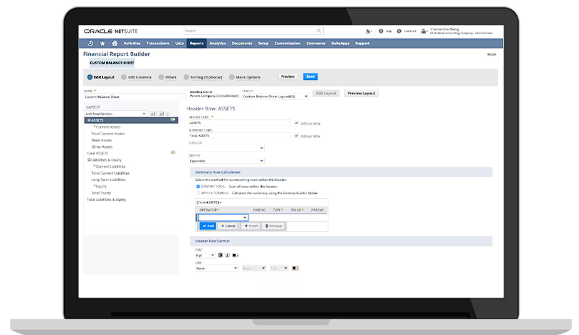
Pros
- Gain real-time insights: Obtain up-to-date information on profitability ratios, margins, tax liabilities, and cash flow.
- Automate administrative processes: Streamline repetitive tasks to save time and reduce errors.
- Integrate with Cube: Seamlessly work with Cube for enhanced functionality.
Cons
- Presents a steep learning curve.
- Comes with higher costs compared to some competitors.
- Features limited customization options.
Pricing: NetSuite provides custom pricing.
3. Sage Intacct

Sage Intacct is financial reporting software that prioritizes increased user efficiency and extensive reporting customization.
Users can use its drag-and-drop design to create reports based on math functions, aggregations, transaction details, grouping, and other criteria.
This platform works for various industries, like SaaS (software-as-a-service) and hospitality.
Features:
- Multi-entity usage: Quickly consolidate multiple entities.
- Cloud solution: Access data and tools from anywhere with the cloud.
- Salesforce integration: Seamlessly integrate with Salesforce.
- General ledger with predefined dimensions: Access comprehensive general ledger management.
- Collaboration feature: Facilitate team collaboration.
- Reports: Access 150+ built-in reports and create custom ones.
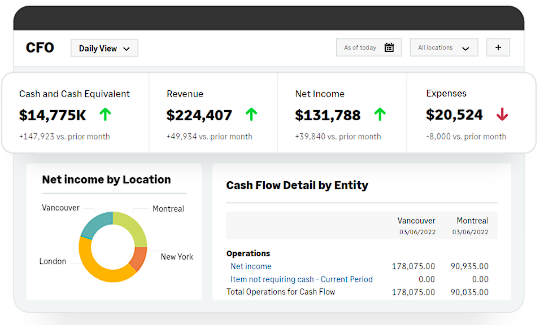
Pros:
- Features a user-friendly interface.
- Tracks key metrics with comprehensive reporting capabilities.
- Makes reports more accessible with visualizations.
- Integrates with Cube.
Cons:
- Some integrations may feel clunky.
- Search functionality may be lacking.
- Comes with a steep learning curve.
Pricing: The platform doesn’t provide pricing online.
4. Insight Software
.jpeg?width=249&height=70&name=insightsoftware_DETAIL%20(1).jpeg)
A French tech company, Insight Software promises to reduce your closing and reporting times by 50%. It features custom reports and Excel integrations. This company bases pricing on increased features measured by claims of improved efficiency up each tier.
Features:
- Export to Excel: Export data from ERP systems to Excel.
- Spreadsheet server reporting: Generate reports directly from spreadsheets.
- Data integration and formatting: Integrate, format, and prepare data efficiently.
- Custom reporting: Create detailed custom reports.
- Integrations: Seamlessly integrate with some financial software.
- Equity management: Manage equity with ease.
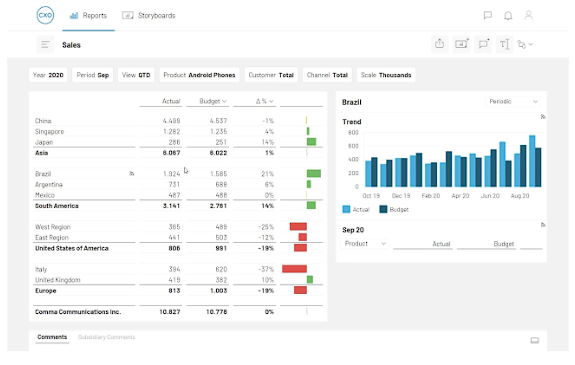
Pros:
- Platform is easy to navigate and use.
- Offers quick training on the system.
- Allows you to drill down into data easily.
Cons:
- Has some occasional bugs and issues.
- Customer service may be lacking.
Pricing: Insight offers custom pricing only.
5. Workday Adaptive Planning

As its name suggests, Workday Adaptive Planning is a planning tool that boasts visible insights at the click of a button. The software is an alternative to Mosaic and other visual planning competitors. Note that Workday Adaptive Planning reviews cite frustration with translating advanced insights to non-finance audiences.
Features
- Budgeting and forecasting: Support comprehensive budgeting and forecasting.
- Analytics and reporting: Gain insights through detailed analytics and reporting.
- Scenario planning: Enable scenario planning for better decision-making.
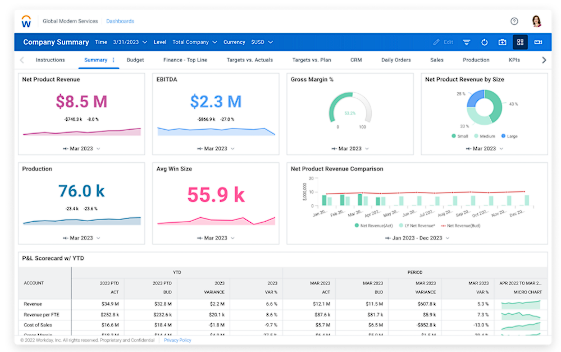
Pros:
- Predictive models: Utilize advanced predictive models.
- Time-saving: Save time with efficient processes.
- Cloud-based software: Access data and tools from anywhere with the cloud.
- Cross-brand Integration: Seamlessly integrate with the Workday suite of programs.
- Integrate with Cube: Enhance functionality with Cube integration.
Cons:
- Lacks training resources.
- Presents a steeper learning curve for advanced features.
Pricing: They offer two different plans with custom pricing.

6. Board

Board is a financial reporting software that helps businesses improve financial processes and accounting.
It even allows users to create custom planning and analysis applications. The platform unifies metrics, analytics, and reports into one place.
Features:
- Capital needs evaluation: Assess and optimize resource usage.
- AI-driven performance analysis: Use AI for predictive performance analysis.
- Model at speed: Access real-time financial modeling.
- Multi-user data entry: Support data entry from multiple users.
- Adaptive aggregation: Enable adaptive data aggregation.
- ERP database write-back: Write back to ERP system databases.
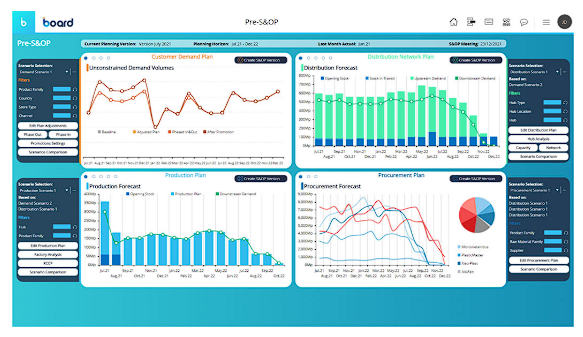
Pros:
- Creates dashboards without technical expertise.
- Provides valuable, actionable insights.
- Adapts the program to your specific needs.
Cons:
- Comes with a steep learning curve.
- Users report potential privacy concerns.
- Users report that customer service is slow to respond.
- Interface may not be intuitive.
Pricing: Board doesn’t list prices on their website.

7. Planful (formerly Host Analytics)

Planful, formerly known as Host Analytics, has skilled professionals with enterprise software, HR, and growth experience. While reviews praise the platform's user-friendly interface, some criticism cites issues with accuracy when updating formulas and reports.
Features:
- Excel reporting and integrations: Create reports and integrate with Excel.
- Data visualizations: Enhance reports with data visualizations.
- Personalized dashboards: Create custom dashboards.
- Forecasting: Enable accurate forecasting.
- What-if scenarios: Run various what-if scenarios.
- Journal entry management: Manage journal entries efficiently.
- Report consolidation: Consolidate reports for a comprehensive view.
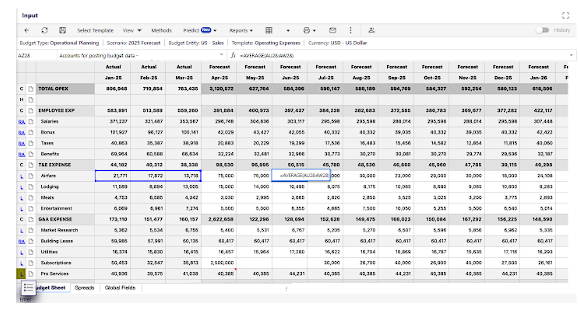
Pros:
- Offers reliable and responsive support team.
- Gives templates for efficiency.
Cons:
- Presents potential accuracy issues when updating formulas.
- Collaboration may be challenging.
- Comes with a steep learning curve.
Pricing: Planful's pricing is not publicly disclosed.
8. Multiview ERP

Multiview ERP features a team of in-house support along with its financial software. It delivers year-round insights, data visualizations, and customization capabilities through core accounting, business insights, business automation, and inventory management.
Features:
- Asset management: Efficiently manage assets.
- General ledger maintenance: Keep detailed financial records.
- Accounts payable and receivable: Streamline payment processing.
- Budgeting and forecasting: Facilitate accurate budgeting and forecasting.
- Workflow automation: Automate various workflows.
- Business intelligence: Gain valuable business insights.
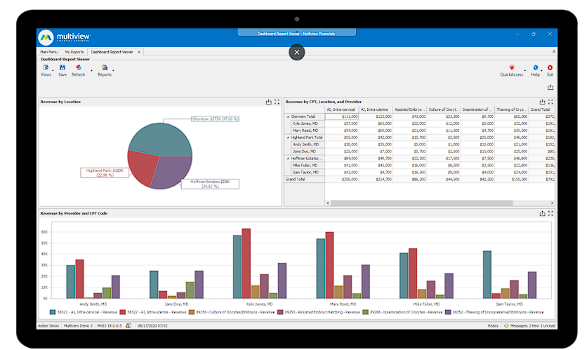
Pros:
- Efficiently searches for specific data.
- Provides access to strong and responsive support.
Cons:
- Creating custom reports may be challenging.
- Presents occasional glitches and issues.
Pricing: Multiview doesn't list pricing online.

9. SAP S/4HANA Finance

SAP S/4HANA Finance is group reporting software from SAP. It's best for businesses that are already entrenched within the SAP ecosystem.
It promises to help streamline financial consolidation and close processes by unifying operational and group reporting.
Features:
- Deployment flexibility: Choose between on-premise, cloud, or hybrid deployment.
- Unified reporting: Consolidate entity and group close reporting.
- Continuous accounting: Enable continuous accounting functionality.
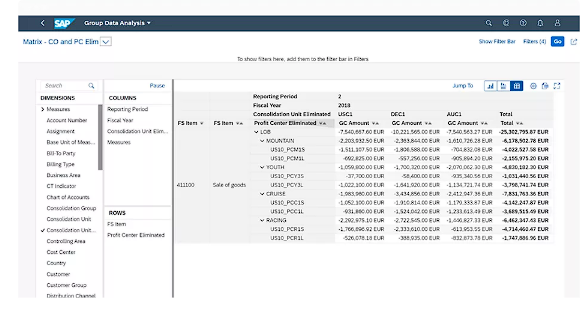
Pros:
- Gives access up-to-date information in real time.
- Speeds up the financial close process.
- Unifies consolidation and transactional activities.
Cons:
- Lacks robust integrations.
- Customer support response times may be slow.
- Setup and maintenance can be complex.
- Creating customized reports can be challenging.
Pricing: Pricing is not publicly available.
10. Workiva

Workiva offers a cloud-native platform for assured integrated reporting, combining financial reporting, ESG reporting, audit, and risk management into one environment. It aims to provide data clarity and accuracy while enhancing collaboration and efficiency across various business processes.
Features:
- Integrated reporting: Conduct comprehensive financial and ESG reporting.
- Risk management: Manage audit and risk efficiently.
- Data connectivity: Facilitate seamless data connectivity and management.
- Collaboration tools: Enhance team collaboration.
- Data automation: Automate data refresh and updates.
- Security: Access secure data handling.
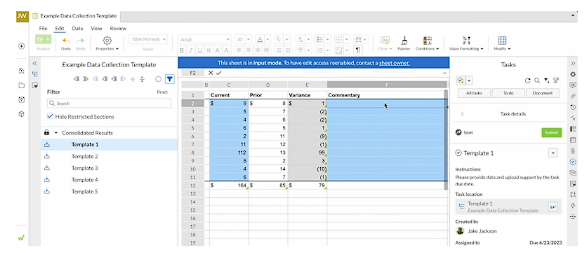

Pros:
- Uses a secure, centralized reporting platform.
- Integrates across financial, ESG, audit, and risk domains.
- Automates manual tasks to increase efficiency.
- Provides access to real-time data updates.
- Improves collaboration and control.
Cons:
- It may be complex for smaller businesses.
- Comes with potentially high implementation and training costs.
- Requires ongoing management and oversight than other systems.
Pricing: Workiva doesn’t publicly disclose pricing.
11. Jedox

Jedox is a financial planning and analysis solution recognized for its adaptability and comprehensive planning capabilities. It supports collaborative planning, budgeting, forecasting, and performance management.
Features:
- Financial planning and analysis: Access comprehensive tools for financial planning.
- Integrated business planning: Facilitate integrated business planning.
- ESG reporting: Access tools for ESG reporting.
- Excel-like interface: Use an interface similar to Excel.
- AI-driven insights: Gain insights with AI-driven tools.
- Multidimensional data analysis: Analyze data across multiple dimensions.
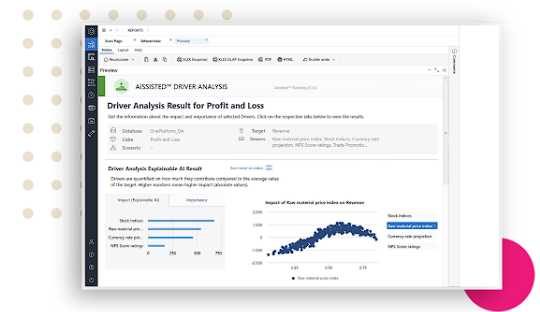
Pros:
- Offers an Excel-like interface that is easy to navigate.
- Adapts to various business models.
- Integrates data from multiple sources.
- Plans and forecasts in real time.
- Comes with strong collaboration features.
Cons:
- Requires significant customization.
- Integration setup can be complex.
- Users face a higher initial setup and training time.
Pricing: Each plan requires a custom quote.
12. Microsoft Dynamics 365 Finance

Dynamics 365 Finance is an enterprise-grade ERP and financial reporting platform built on Microsoft’s Power Platform. It provides finance teams with standard financial statements built on live transactional data. It also connects directly with the wider Microsoft ecosystem—Excel, Power BI, Power Automate, and Dataverse—so teams can refresh reports instantly, embed visuals, or trigger workflows.
Features:
- Financial report builder: Create balance sheets, income statements, and cash-flow reports using over 22 built-in templates
- Drill-through reports: Go from high-level summaries into specific account entries or vouchers to investigate transactions from within your report viewer.
- Report scheduling: Schedule single or grouped reports to run daily, weekly, or monthly.
- Electronic reporting: Generate tax- and regulatory-compliant documents using the Electronic Reporting (ER) tool.
- Embedded analytics: Use Power BI models within Finance to build interactive dashboards that auto-update with ERP data for deeper insight.
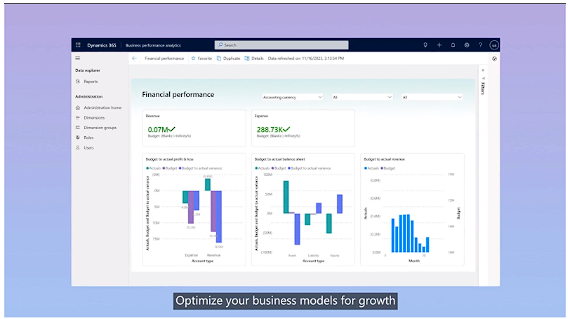
Pros:
- Delivers a unified reporting environment with shared authoring, role-based control, and audit logs.
- Native integration with Excel and Power BI makes it easy to visualize and export data in familiar formats.
- Supports automated, on‑schedule report delivery for month‑end and board reporting.
Cons:
- Its ERP-first setup can feel complex and may require IT or consulting help to deploy effectively.
- Custom reports or integrations often need technical resources or partner support.
- Licensing and implementation costs increase as you add modules.
Pricing:
- Dynamics 365 Finance: $210/ mo per user
- Dynamics 365 Finance Premium: $300/mo per user
Best financial reporting software for startups and smaller businesses
Startups and small businesses need simpler software that’s easy to use and works with their existing systems. Let’s explore financial reporting tools that are well-suited for lean teams.
1. Sage 50 Cloud

You might remember Sage Intacct, which we covered previously in this review. However, the company also offers a cloud version called Sage 50cloud Accounting. This financial reporting software is similar to Intacct, but users can access their files anywhere.
Additionally, it’s a decent financial reporting software for companies requiring Microsoft 365 integration.
Features:
- Advanced budgeting and reporting: Create detailed business budgets and reports.
- Cash flow management: Efficiently manage cash flow, income, and expenses.
- Real-time inventory management: Track inventory in real time.
- What-if scenarios: Run frequent what-if scenarios for better decision-making.
- Secure data sharing: Share data securely with accountants.
- Sales invoice management: Manage sales invoices and track expenses effectively.
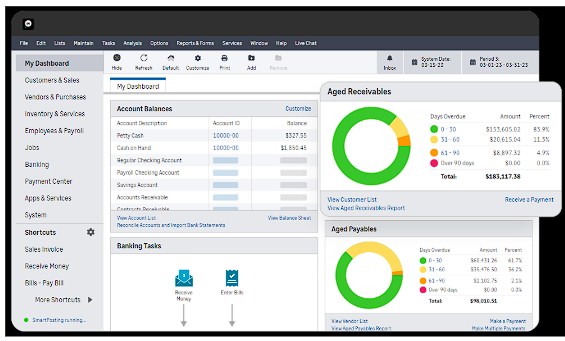
Pros:
- Seamlessly integrates with Microsoft 365.
- Enables users to customize reports to fit all needs.
Cons:
- Limits permissions to the most expensive plan.
- Presents higher costs for larger teams.
- Advanced reporting only available on higher-tier plans.
Pricing:
- Pro Accounting: $625/year
- Premium Accounting: $1,043/year
- Quantum Accounting: $1,780/year
2. Datarails

Datarails is a legacy Excel-friendly platform for FP&A teams at small to midsize businesses. It helps teams forecast their finances and plan operations accordingly. If you’d like to read more about Datarails and other FP&A software solutions, check out our Datarails competitors article.
Features:
- Version control: Automatically back up and manage versions.
- Logical version comparison: Compare different versions logically.
- Cell drill-down: Drill down into specific cells for detailed information.
- Error prevention: Prevent spreadsheet errors and data loss.
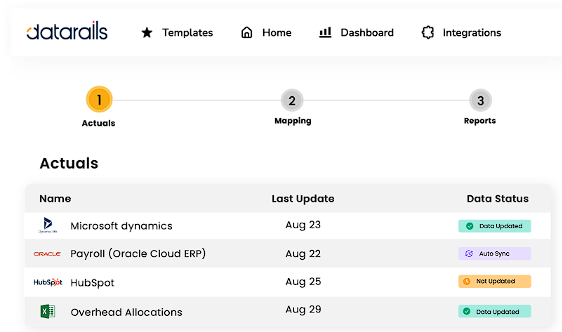
Pros:
- Offers user-friendly dashboards.
- Keeps your FP&A team within Excel.
- Utilizes a mix of formulas and coding with a refreshed UI.
Cons:
- Limits functionality on Mac.
- Lacks compatibility with Google Sheets.
- Requires additional licenses for collaboration.
- Uses proprietary formulas and hidden columns in reports.
- Replaces much of your backend, making offboarding difficult.
Pricing: Datarails doesn't disclose prices online.

3. Jirav
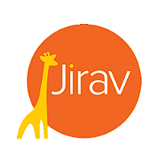
Jirav is a driver-based planning platform that gets FP&A teams out of spreadsheets.
Jirav is a great tool if:
- You're part of the 5% of finance professionals who don't believe advanced spreadsheet skills are essential for FP&A managers
- You prefer a driver-based approach to planning
- You want a strict cloud-based solution
Otherwise, Jirav is probably not the best fit.
Features:
- Driver-based planning: Use a driver-based approach for planning.
- Templated and custom reporting: Create both templated and custom reports.
- Shareable dashboards: Share dashboards with anyone, even without a Jirav license.
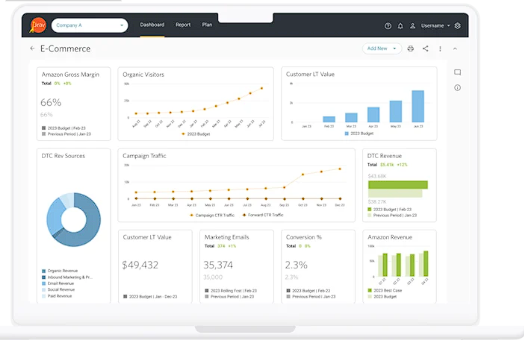
Pros:
- Allows users to access data and tools from anywhere with the cloud.
- Offers more affordable pricing compared to some competitors.
- Shares dashboards easily with others.
Cons:
- Replaces existing Excel models.
- Comes with slower processing
Pricing: Business pricing is not publicly available.
4. Xero
.png?width=318&height=159&name=xero-logo%20(1).png)
Xero is an accounting software with some reporting features, though its primary functions are payroll, expenses, and invoicing.
Track and pay bills, claim expenses, connect to your banks, track payments, use Gusto payroll software, manage Xero contacts, and much more.
Features:
- Work with your team: Collaborate effectively within the platform.
- Customizable reports: Create and customize reports to fit your needs.
- Budget vs. actuals comparison: Use formulas to compare budgets with actuals.
- Lock dates: Prevent changes to finalized periods.
- Search functionality: Easily search for specific data.
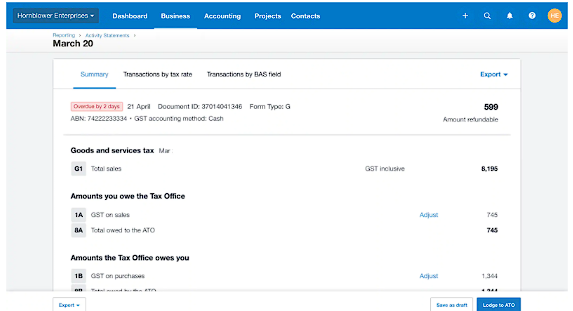
Pros:
- Provides 24/7 customer support.
- Enables users to generate interactive and KPI-specific reports.
- Tracks different business departments effectively.
- Integrates with Cube.
Cons:
- Lacks advanced functionality.
- Integration options with other financial software may be limited.
Pricing:
- Early: $20/month
- Growing: $47/month
- Established: $80/month
5. Synoptix

Synoptix is a legacy financial reporting tool that replaces your custom Excel reports to move everything to the new platform, like many other tools on this list.
Features:
- KPI dashboards: Create dashboards highlighting key performance indicators.
- Custom reports: Produce detailed custom reports.
- Real-time analytics: Access real-time analytics.
- Drill-down functionality: Drill down into data for detailed information.
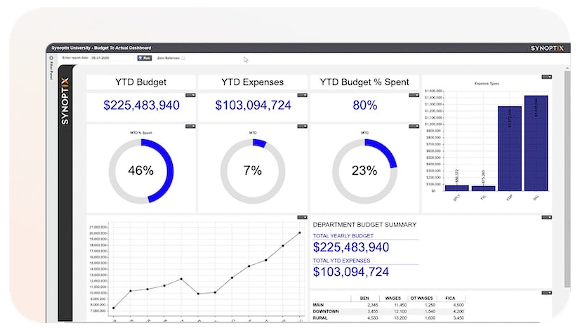
Pros:
- Helps teams create annual financial statements efficiently.
- Software is suitable for a wide variety of businesses.
Cons:
- Lacks some advanced features.
- User interface may be difficult and outdated.
- Updates to the desktop version and online portal may be mismatched.
Pricing: Pricing is not publicly available.
6. Vena Solutions

Vena Solutions is financial reporting software dedicated to helping businesses seamlessly integrate advanced reporting with Excel data.
A cloud solution, Vena offers reporting to include what-if scenarios and prepare for cash and budget planning. However, customers cite a long learning curve and limited training opportunities.
Features:
- Financial management tools: Comprehensive tools for managing finances.
- Financial and ad-hoc reporting: Create detailed financial and ad-hoc reports.
- Real-time insights: Gain insights with real-time data.
- Templates for financial statements: Access templates for various financial reports.
- Quick ad-hoc variance analysis: Perform variance analysis efficiently.
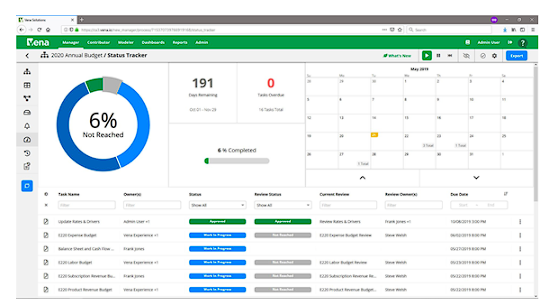
Pros:
- Provides access to the platform on mobile devices.
- Features an easy-to-navigate interface.
- Seamlessly integrates with Excel.
Cons:
- Loading may require longer wait times.
- Training resources may be limited.
- Customization options may be lacking.
Pricing: Vena Solutions doesn't list prices on its website.

7. Intuit QuickBooks

Intuit QuickBooks is a great introductory financial analysis software for freelancers and small or growing businesses.
While it's one of the world's most popular accounting software, it falls short as a financial reporting software due to its limited capabilities in advanced and custom financial report generation.
For example, you can customize profit and loss statements and other reports by vendor or employee, but not by unique market conditions to prepare for future strategy.
Larger organizations might need more robust software to capture all their insights.
Features:
- Customizable templates and quotes to invoices: Tailor templates to fit your business needs and convert quotes to invoices from any device.
- Expense management: Track and manage expenses efficiently.
- VAT and GST support: Handle value-added tax and goods and services tax compliance.
- Inventory management: Automatically update inventory and get low stock alerts.
- Insights and reports: Gain valuable business insights and generate detailed reports.
- Multi-currency transactions: Conduct transactions in multiple currencies.
- Financial consolidation: Consolidate financial data for a comprehensive view.
- Easy bookkeeping: Simplify tax filing with stress-free bookkeeping.
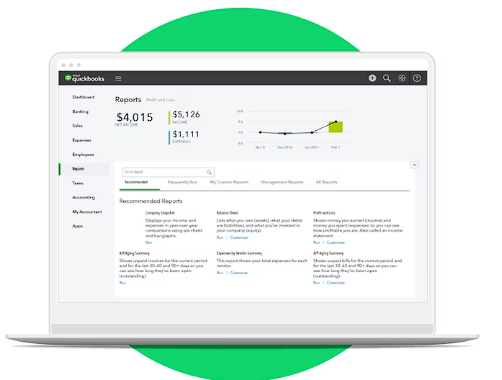
Pros:
- Provides user-friendly software.
- Seamlessly integrates with other tools and systems.
- Serves as a cost-effective option for individuals and smaller businesses.
- Integrates with Cube
Cons:
- Offers limited ability to create custom reports.
- Customer support may be lacking.
- May not be ideal for larger companies.
Pricing:
- Simple Start: $19/mo
- Essentials: $28/mo
- Plus: $40/mo
- Advanced: $76/mo
8. FreshBooks
.png?width=375&height=110&name=freshbooks-logo-1%20(1).png)
Freshbooks is even more tailored to freelancers and small businesses, functioning primarily as invoicing software. You can generate seven types of reports through this software, but custom capabilities are limited.
Customers praise the platform's user-friendly interface and affordability but complain about frequent crashes.
Features:
- Budget and sales tax summaries: Create detailed budget and sales tax summaries.
- Profit and loss reports: Generate comprehensive profit and loss reports.
- Accountant access and permissions: Grant access and set permissions for accountants.
- Expense reports: Produce detailed expense reports.
- Balance sheet reconciliation: Reconcile balance sheets easily.
- Journal entry tracking: Keep track of all journal entries.
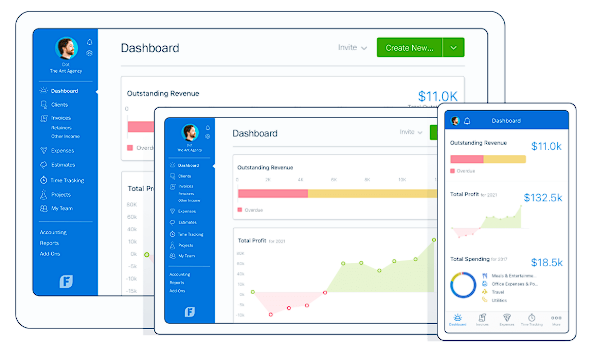
Pros:
- Serves as a cost-effective option, including a free trial.
- The interface is easy to navigate and use.
Cons:
- Some users experience slow loading times and occasional crashes.
- Primarily focuses on invoicing rather than comprehensive accounting.
- Rigid interface limits flexibility in some features.
- Better suits smaller operations.
Pricing:
- Lite: $21/mo
- Plus: $38/mo
- Premium: $65/mo
- Select: Custom pricing available
9. Zoho Books
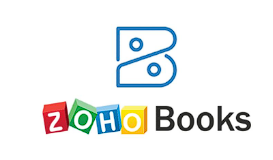
Zoho Books is an accounting platform designed for growing businesses, offering a wide range of features to manage accounting tasks, organize transactions, and ensure tax compliance. It is known for its usability, security, extensibility, and reliability.
Features:
- Invoicing and billing: Efficiently manage invoicing and billing processes.
- Sales and purchase orders: Handle sales and purchase orders seamlessly.
- Project management: Facilitate project management.
- Bank reconciliation: Simplify bank reconciliation.
- Inventory management: Track and manage inventory.
- Expense tracking: Keep track of expenses.
- Sales tax compliance: Ensure compliance with sales tax regulations.
- Mobile and desktop access: Access the platform from mobile and desktop devices.
- Customizable templates: Create and customize templates.
- Document management: Automate document management processes.
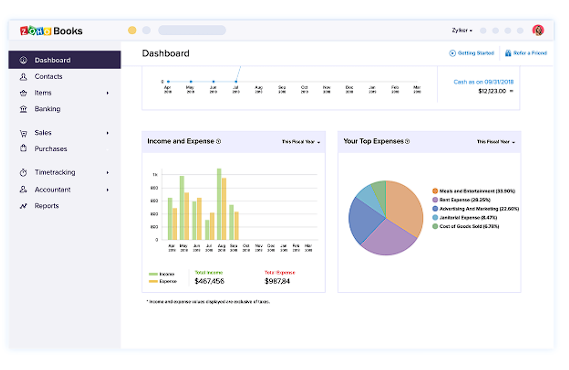
Pros:
- Offers a user-friendly interface.
- Provides strong security features.
- Integrates with over 300 business apps.
- Features cost-effective pricing options.
- Gives users access to reliable customer support.
Cons:
- Limits advanced features compared to competitors.
- Better suits for small to medium-sized businesses.
- Updates occasionally disrupt workflow.
Pricing:
- Free: $0.
- Standard: $20/month
- Professional: $50/month
- Premium: $70/month
10. Wave

Wave is a cloud-based accounting and reporting platform that offers core bookkeeping tools like invoicing, bank reconciliation, and financial statements. It organizes reports into categories for financial statements, taxes, payroll, customers, vendors, and detailed transactions, so you can locate the exact insight you need. Wave aims itself towards freelancers, solopreneurs, and small businesses looking for simple setup and reliable reporting.
Features:
- Basic financial statements: Access auto-generated profit and loss, balance sheet, and cash flow reports that update with your banking and transaction activity.
- Bank reconciliation: Connect multiple bank and credit-card accounts with Plaid for auto-imports, categorization, and monthly reconciliation.
- Tax and payroll: Generate basic sales and payroll tax reports.
- Customer and vendor analytics: Track income by client, aged receivables, payables, and vendor spending.
- Transaction exports: Export general ledgers, account balances, and transaction history for deeper analysis or tax prep.
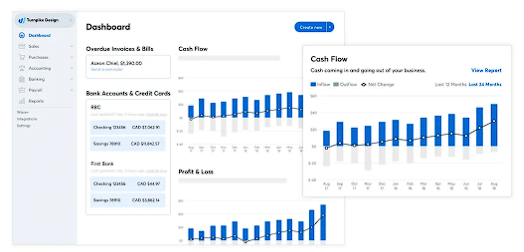
[Source]
Pros:
- Offers unlimited bookkeeping, invoicing, and reporting at zero cost.
- Auto-imports, categorizes, and reconciles transactions without manual entry.
- Presents reports in a straightforward and easy-to-understand way.
Cons:
- Does not support budgeting, custom reports, inventory, or ERP integrations.
- Features like bank auto-imports, payroll, payments, and expert support come at a cost.
Pricing:

How to choose the right financial reporting solution
No two finance teams are the same. We can tell you what to look for, but ultimately, it's up to you to decide which financial reporting software fits your needs. As you evaluate options, consider the following:
- Functionality: Talk with your team to list out the features they need most. Do they need customizable reports, real-time data updates, automated data consolidation, or all of the above? The best tools enable you to drill down into data for detailed insights, making it easier to track financial health, analyze performance, and create presentations for stakeholders.
- Integration: Your software should work seamlessly with existing systems, like accounting tools, ERP platforms, or CRM software. Consider how well it syncs with common spreadsheet tools like Excel and Google Sheets, which many teams still rely on.
- Scalability: Think about where your business is headed. Will the software handle increased reporting demands and data complexity as you grow? Look for features that can keep up with your business so you don’t feel the need to upgrade software all over again anytime soon.
- User experience: Even the most powerful software can fall short if it’s difficult to use. Check user reviews for an intuitive interface with clear navigation, easy setup, and training resources. Consider whether it has role-based dashboards that let users see only what’s relevant to their job, which can simplify the experience for different teams.
- Security: Financial data is sensitive, so strong security measures are a must. Look for features that protect against data breaches or system failures.
Upcoming financial reporting software trends
Here are some key trends pushing financial reporting forward:
- AI and automation: Financial reporting software is increasingly incorporating AI to enable automated financial reporting, streamline daily tasks, and analyze data. With AI forecasting capabilities, these tools generate more accurate predictive insights, helping finance teams anticipate future trends and outcomes.
- Real-time data processing: Real-time data processing features are becoming better at providing businesses with the most current financial information, automatically updating reports and dashboards without manual input. Instead of waiting hours or even a day for data updates, finance teams can see changes instantly. This immediate access helps teams respond faster and make more timely, informed decisions.
- Use of blockchain technology for enhanced security: Blockchain technology offers a secure, transparent way to record financial transactions. It can provide an immutable ledger of transactions to reduce the risk of fraud, make audits more efficient, and improve stakeholder trust.
- Cloud-based solutions: Modern businesses are embracing remote work and online collaboration. Cloud platforms provide easy access to reports and data from anywhere with an internet connection. When someone makes an update to the data, everyone with access can see the updates too.
- Customizable dashboards: More platforms are incorporating customizable dashboards to let users tailor reports and visuals to highlight their most important metrics. Different departments and stakeholders care about different aspects of the business and prefer when data is presented in a way that makes sense for their role.
Choose the best financial reporting software for your business
No business became successful without any support. Be it through a team of skilled professionals or machine learning tech, the best organizations offload the busy work so they can spend more time scaling.
By leveraging the right financial reporting software, businesses can streamline their financial processes, gain deeper insights, and make data-driven decisions that drive growth.
Request a free demo today to see if Cube is the right fit for your business.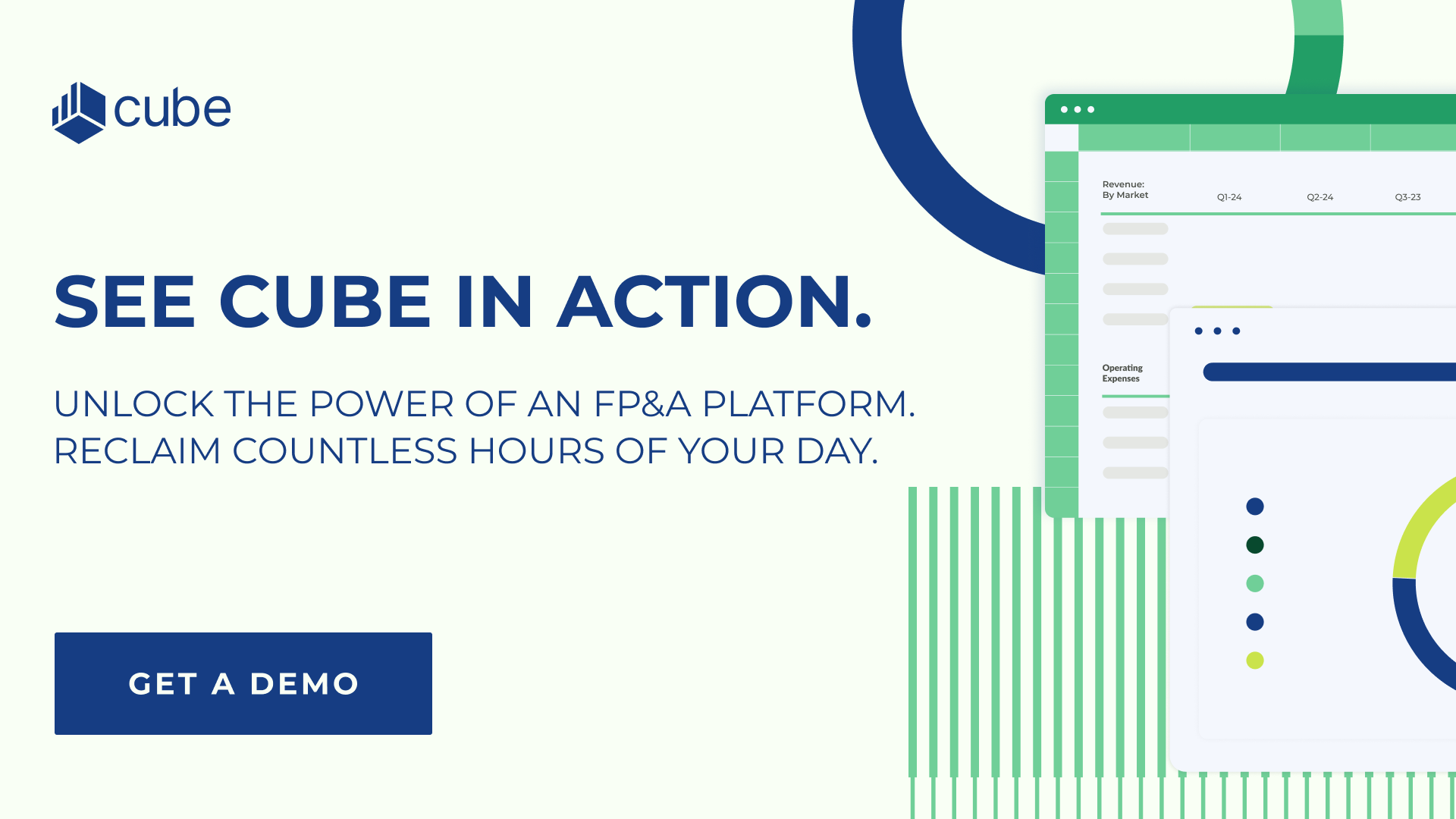


.png)


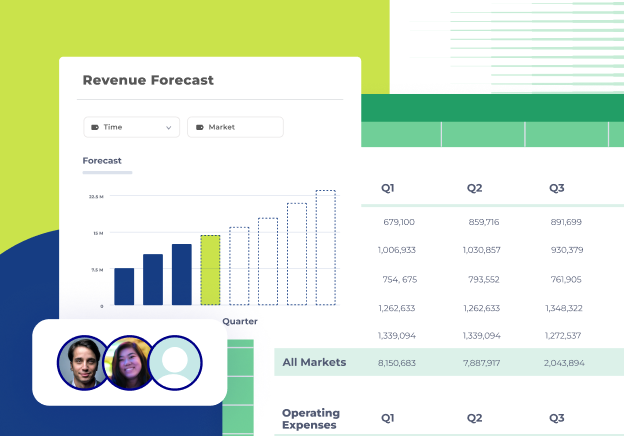


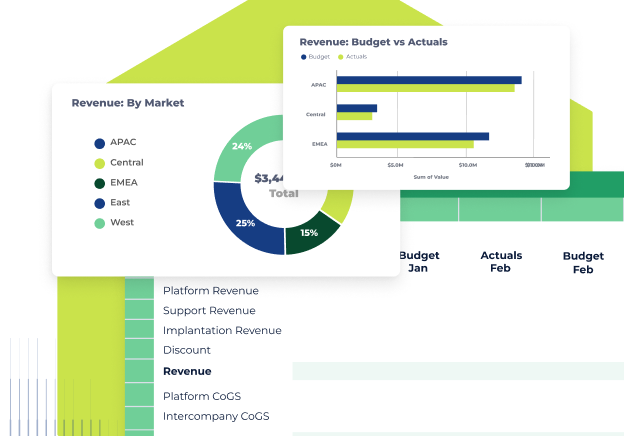



.png)

.webp)




.jpeg?width=249&height=70&name=insightsoftware_DETAIL%20(1).jpeg)

























.png?width=318&height=159&name=xero-logo%20(1).png)








.png?width=375&height=110&name=freshbooks-logo-1%20(1).png)






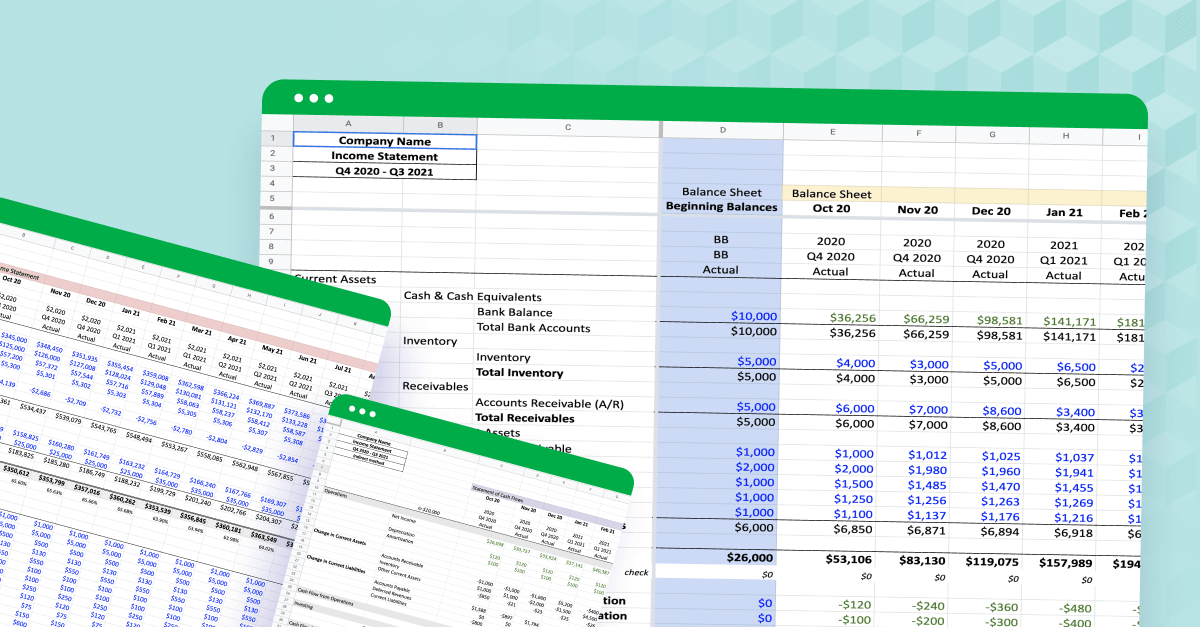
.png)
![14+ of the best financial consolidation tools [2025]](https://www.cubesoftware.com/hubfs/Blog%20image%20(91).png)